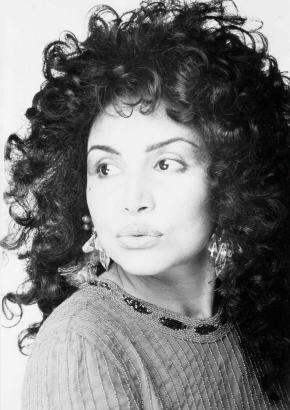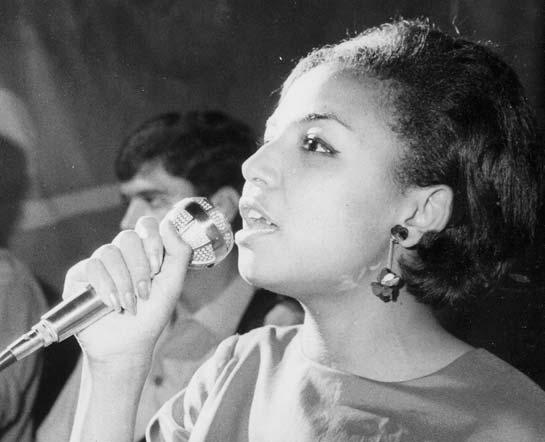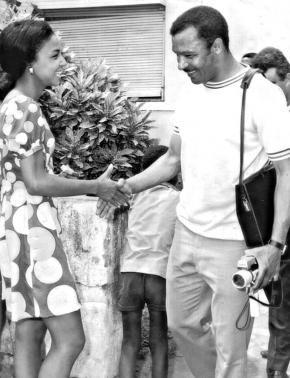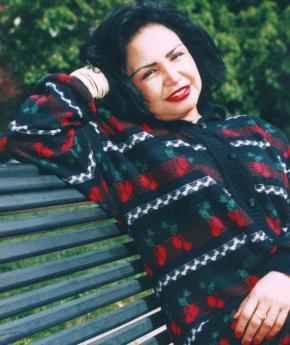Milita. The song of the butterfly.
She started to walk when she was only two, then to talk and then … to experience the happy feeling of song. She was born on 28 April 1948 in Luanda, the result of an unexpected pregnancy. Her name was Camilinha – Camila Máxima Pinto de Meireles on the registry – and she sang and danced all around the house. She was influenced by Aninhas (Ana Astrid) and by her sisters Ondina and Nina. As she recalls: “They taught me dance steps and songs, they encouraged me to show relations and friends what I could do (and in return I got sweets, mainly from Xika Kayoyo – the best I can remember).”
Her singing talent was so clear that she was only three when she caught the eye of Tito de Assunção, founder of the Grupo Folclórico de Angola. The young singer rapidly became the group mascot and found herself among such names as Liceu Vieira Dias, Nino Ndongo (Ngola Ritmos) and Chico Viola (Cinco de Luanda).
The years from 1951 to 1955 were auspicious. When she was a mere four years old, she was happiness personified. There she was, on stage in the best theatres of Angola. Applause and coins rained down on her and she always got a doll and presents. This had to be, if she was going to sing and dance, Carmen Miranda style! The blood of an artist was already coursing through her veins.
 Milita archives.In 1955 the early career came to a halt (a parental instruction) and she started primary school in School 7. Among her schoolmates was one destined to become king of Angolan radio – João Arsénio. Those times are etched in her memory: “Between 1952 and 1957 Luanda was overflowing with life. There were fantastic street carnivals, with fuba battles and long parades of floats and vans (with everyone following, sometimes carrying chairs and benches!). Then there were the picnics under the shade of the cashew nut trees in Belas, on the streets of Katete and Kakwaku, or anywhere that had undergrowth, and the popular parades, where my sisters always joined in, and the S. João and S. Pedro bonfires. And the competitions for singers? My sister Nina had a wonderful voice (I wish I had one like her!) and she took part in two of them, representing our neighbourhood, Maianga. She was elected Queen of Singers of the Maianga district, with a beautiful fado song “Quando os outros te batem, beijo-te eu” (When others beat you, I shall kiss you) by Amália Rodrigues.”
Milita archives.In 1955 the early career came to a halt (a parental instruction) and she started primary school in School 7. Among her schoolmates was one destined to become king of Angolan radio – João Arsénio. Those times are etched in her memory: “Between 1952 and 1957 Luanda was overflowing with life. There were fantastic street carnivals, with fuba battles and long parades of floats and vans (with everyone following, sometimes carrying chairs and benches!). Then there were the picnics under the shade of the cashew nut trees in Belas, on the streets of Katete and Kakwaku, or anywhere that had undergrowth, and the popular parades, where my sisters always joined in, and the S. João and S. Pedro bonfires. And the competitions for singers? My sister Nina had a wonderful voice (I wish I had one like her!) and she took part in two of them, representing our neighbourhood, Maianga. She was elected Queen of Singers of the Maianga district, with a beautiful fado song “Quando os outros te batem, beijo-te eu” (When others beat you, I shall kiss you) by Amália Rodrigues.”
While her sister was making a name for herself with fado music, Milita was coming to feel the pull of the music world. Her parents “would never hear of it” but the young singer insisted so much that they ended up by letting her have her way and they enrolled her in classes run by Lili Apanaz, a piano teacher for the Liga Nacional Africana (African National League).
As she heard more great voices, her liking for them grew. At 10, Camilinha was an inveterate fan of Sarita Montiel. Among Portuguese artists, she loved Maria Fátima Bravo, Amália Rodrigues and Maria de Lurdes Resende. And the enchantment of Brazil reached her through the tunes of Albertino Fortuna, Miltinho, Dalva de Oliveira and Maysa. But it was the warm tones of the Brazilian singer Angela Maria that she really admired, to the point where she knew practically the whole repertoire. “I never modelled myself on her, but there was a time that I was known as Ângela Maria de Angola.”
When she finished primary school, she moved on to secondary education at the Liceu D. Guiomar de Lencastre. From there she went on to the Liceu Salvador Correia where she finished 7th year, the last year of schooling. Soon, however, her life was to turn upside down. It came silently, from the microphones of the Emissora Oficial de Angola (the official Angolan broadcaster). It was 1961. “A friend told me of the competition “Search for a Star”, put on by the Portuguese singer Manuel Moreno on the programme “New Faces”. It was fundamentally a singing academy that launched its pupils into the world of music. I was determined to join. Between 1961 and 1963 I spent long, happy hours of my youth honing my voice and developing my artistic vein. The first song I sang was “Vocês sabem lá” (You can’t possible know) by Maria de Fátima Bravo. Then came Argentinian tangos and the Brazilian sounds of Carlos Gardel, Albertino, Dalva de Oliveira and my very own Ângela Maria. Then came French songs – Charles Aznavour and Patrícia Carli. My greatest successes were “Ave Maria do Morro” and “La Mamma.” And thus was born the singer MILITA.
 Performing in Luanda, in 1969. Milita archives.
Performing in Luanda, in 1969. Milita archives.
After many years without treading the boards, Milita made her first public appearance in “Cazumbi” by Luis Montez (1963) at the Cine Miramar. Success was not long in coming. The Duo Ouro Negro were already world famous, and on one of their trips back to Angola they invited the young singer and Cândido Coutinho to join them in a programme on “Chá das 6.” The experience was so positive that they invited her on the spot to go with them on tour to Carmona (Wíji). Milita’s comment, even today, is “It was marvellous.” Her career rapidly took off. In 1964, in the 7th Luanda Song Festival, she was considered the most popular female singer in Angola. Between then and 1966, her reputation carried her on a long journey to the farthest corners of the nation with the group “Os Gansos”, with Casa Pia and artists such as Manuel Alcobia, João Luis and Maria Judite. A year later she was awarded the diploma of honour in the 9th Luanda Song Festival. Shows followed at hectic spreed “I sang just about everywhere – with Senhor Abrantes, in the São Paulo Club, in Marítimo da Ilha, in Ngola Cine and the famous Colonial o Clo Clo, in shows put on during the intervals of films. I had the great honour of being accompanied by excellent conductors – Casal Ribeiro and Jaime Mendes – and the group Ngola Ritmos.”
 Greeting Mário Coluna in 1970. Milita archives.In 1969 she toured outside Angola for the first time: in Mozambique. It was the first of many journeys. In the following years, Milita was to journey with bags and baggage to the four corners of the world, with music ever in her heart. Then her career took another turn. In Brazil, where she stayed for a number of years, she performed in the Double Dose in the Teatro Mundial in São Paulo, and she had singing lessons with Regina Silvares, Márcia Tannuri and Vera Canto Melo. In 1987 she played the role of “Milita de Angola” in the film “Eternamente Pagú”. This was the first film directed by the Brazilian Norma Benguell, and she played opposite Carla Camurati and sang the “Hino da Liberdade” (Song of Freedom) with lyrics by Clara Werneck.
Greeting Mário Coluna in 1970. Milita archives.In 1969 she toured outside Angola for the first time: in Mozambique. It was the first of many journeys. In the following years, Milita was to journey with bags and baggage to the four corners of the world, with music ever in her heart. Then her career took another turn. In Brazil, where she stayed for a number of years, she performed in the Double Dose in the Teatro Mundial in São Paulo, and she had singing lessons with Regina Silvares, Márcia Tannuri and Vera Canto Melo. In 1987 she played the role of “Milita de Angola” in the film “Eternamente Pagú”. This was the first film directed by the Brazilian Norma Benguell, and she played opposite Carla Camurati and sang the “Hino da Liberdade” (Song of Freedom) with lyrics by Clara Werneck.
The years went by and new targets appeared. In 1991 she packed her bags again and travelled to Europe. Here too she had a tight schedule, with shows in the Aula Magna in Lisbon and the Parisian venues Théatre Carré Blanc and Théatre de Draveil. And these were just some of the places where, some nights, she topped the bill.
So many journeys across the globe but Angola always had a big place in her heart. And the tenderness flows both ways. Proof of this was in the homage paid by the TPA in the 1984 programme “Milita veio e cantou” (Milita came and sang). The spotlight was on her, but tributes came from others who went up on stage and sang: André Mingas, Cirineu Bastos, Dionísio Rocha, Ngoleiros do Ritmo and Filipe Mukenga of the Banda Madizeza.
 Milita archives.During these years she kept coming back to her country. In Luanda, she launched the record “Eu sou Angolana” (1995) and she worked with Eleutério Sanches, Mário Rui Silva, Bonga and Michelino Mavitico. In the 30 years of Dipanda, she also took part in the Independence Gala and she sang in the collection featuring the greatest names in Angolan music. In 2005 she took part in the shows put on by Cesária Évora and Alcione and was guest artist at the Caldo da Poeira in homage of Elias dya Kimwezu. She lives now in France, where she founded the association for Angolan artists resident there. Her companion is a Croatian musician who also “does a touch of painting.” Whenever there’s a chance, she’s up on stage. And there’s no better end than her own words: “every time I sing, I live the moment with the same amazement as the butterfly on the only day of its life, perched on the coloured petal of a flower.”
Milita archives.During these years she kept coming back to her country. In Luanda, she launched the record “Eu sou Angolana” (1995) and she worked with Eleutério Sanches, Mário Rui Silva, Bonga and Michelino Mavitico. In the 30 years of Dipanda, she also took part in the Independence Gala and she sang in the collection featuring the greatest names in Angolan music. In 2005 she took part in the shows put on by Cesária Évora and Alcione and was guest artist at the Caldo da Poeira in homage of Elias dya Kimwezu. She lives now in France, where she founded the association for Angolan artists resident there. Her companion is a Croatian musician who also “does a touch of painting.” Whenever there’s a chance, she’s up on stage. And there’s no better end than her own words: “every time I sing, I live the moment with the same amazement as the butterfly on the only day of its life, perched on the coloured petal of a flower.”
in AUSTRAL nº 63, article kindly provided by TAAG - Linhas Aéreas de Angola